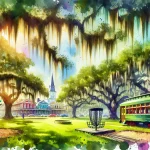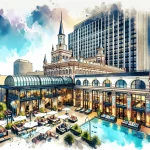Positioned along the bends of the Mississippi River, a mere 15 miles southeast of downtown New Orleans, lies the historic district of English Turn. This picturesque community, renowned for its lush golf courses and stunning antebellum-style homes, boasts a captivating history dating back to the early 18th century. Today, English Turn stands as a testament to the enduring legacy of New Orleans’ colonial past and its ongoing evolution as a diverse, dynamic city.
In This Article
TL;DR
- English Turn played a pivotal role in the early history of New Orleans, serving as a strategic location during colonial conflicts.
- The district now thrives as a residential haven, attracting residents with its upscale homes, golf courses, and recreational amenities.
- English Turn’s architectural landscape blends antebellum mansions with modern luxury homes, reflecting its historical development.
Historical Background of English Turn
The name “English Turn” traces its origins to a seminal moment in New Orleans’ colonial history. In 1699, French explorer Pierre Le Moyne d’Iberville led an expedition up the Mississippi River, aiming to establish a French presence in the region. As they navigated the river’s winding course, they encountered a bend where an English warship lay anchored. The French, who had claimed the territory, demanded that the English vessel turn back, giving rise to the name “English Turn.”
Over the centuries, English Turn witnessed several pivotal historical events. During the Battle of New Orleans in 1815, the area served as a strategic location for American forces led by General Andrew Jackson. The victory over the British in this battle played a crucial role in shaping the young United States’ identity and solidifying its independence.
As New Orleans grew and expanded, English Turn transformed from a rural outpost to a suburban community. The construction of the English Turn Golf and Country Club in 1988 marked a significant milestone in the district’s modern development, attracting affluent residents and establishing the area as a premier residential destination.
Geographical and Demographic Overview
English Turn is situated on a bend of the Mississippi River, providing residents with stunning waterfront vistas and easy access to the river’s recreational offerings. The district’s location, just a short drive from downtown New Orleans, offers a perfect balance of suburban tranquility and urban convenience.
The community is primarily residential, with a population of approximately 3,000 people. English Turn attracts a diverse mix of residents, including young professionals, families, and retirees drawn to the area’s natural beauty, recreational amenities, and proximity to New Orleans’ vibrant cultural scene.
Architectural Highlights
One of English Turn’s most striking features is its variety of architectural styles. The district showcases a blend of antebellum mansions, modern luxury homes, and traditional Louisiana-style houses. Many of the older homes have been meticulously restored, preserving their historical charm while incorporating modern amenities.
Notable buildings in English Turn include the St. Joseph Plantation, a beautifully restored antebellum mansion that now serves as a popular venue for weddings and special events. The plantation’s architecture, with its grand columns and sprawling porches, exemplifies the classic Southern style that has become synonymous with New Orleans.
The architectural diversity in English Turn reflects the broader trends in New Orleans, where a blend of French, Spanish, and African influences has shaped the city’s unique built environment.
Cultural Significance
English Turn’s cultural significance lies in its role as a microcosm of New Orleans’ diverse heritage. The district’s history is interwoven with that of the city, reflecting the influences of French and British colonial rule, the African diaspora, and the American experience.
The community hosts several annual events that celebrate this rich cultural legacy. The English Turn Parade, held each spring, showcases the district’s vibrant spirit with colorful floats, marching bands, and local cuisine. The event draws visitors from across the city and beyond, highlighting English Turn’s role in the cultural tapestry of New Orleans.
Economic Impact and Development
English Turn’s economy is primarily driven by its residential sector, with the English Turn Golf and Country Club serving as a major anchor for the community. The club, which features a championship golf course designed by Jack Nicklaus, attracts golf enthusiasts from across the region and has hosted several prestigious tournaments.
In recent years, English Turn has seen an influx of new development, with luxury homes and condominiums being built along the riverfront. These developments have brought new economic opportunities to the area, including construction jobs and increased property values.
However, like many communities in the New Orleans area, English Turn also faces challenges related to coastal erosion and the threat of hurricanes. The district’s location on the Mississippi River makes it particularly vulnerable to these environmental risks, and the community has been working closely with local and state authorities to develop strategies for resilience and adaptation.
Community and Lifestyle
Life in English Turn is characterized by a strong sense of community and a focus on outdoor recreation. The district’s tree-lined streets and well-manicured lawns create a serene, family-friendly atmosphere, while the Mississippi River and nearby parks provide ample opportunities for hiking, biking, and water sports.
The English Turn Golf and Country Club serves as a hub for community activity, offering not only golf but also tennis, swimming, and social events. The club’s restaurant, The Clubhouse, is a popular gathering spot for residents, serving up classic New Orleans cuisine and providing a venue for neighborhood meetings and events.
Address: 19 Yorktown Drive, New Orleans, LA 70131
Phone: (504) 347-5988
Other community amenities in English Turn include the English Turn Swim and Tennis Club, which offers additional recreational opportunities, and the English Turn Playground, a popular spot for families with young children.
Future Prospects and Challenges
As English Turn looks to the future, the community is focused on balancing growth and development with the preservation of its unique character and natural resources. Several new residential projects are in the works, including luxury apartments and single-family homes, which are expected to bring new residents and economic opportunities to the area.
At the same time, English Turn faces challenges related to coastal erosion, hurricane preparedness, and the need for sustainable development practices. The community has been working closely with local authorities and environmental organizations to develop strategies for addressing these challenges, including shoreline restoration projects and the implementation of green infrastructure.
Despite these challenges, English Turn remains a highly desirable place to live, work, and play. Its combination of historical charm, natural beauty, and modern amenities make it a unique and attractive destination within the greater New Orleans area. As the district continues to evolve and adapt to the changing needs of its residents and the broader community, it is poised to remain a vital and vibrant part of the city’s fabric for generations to come.






